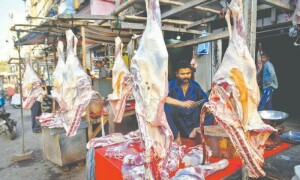Untainted beauty of the land we inherited
Shameen Khan Published
August 14, 2012




















The Himalayas and the Kaghan valley have inspired poets, musicians, painters, videographers and photographers throughout the ages. For me, the inspiration came last month, when my friends revealed they were planning a trip.
Today I share a look at the untainted beauty of the land we inherited, celebrating Pakistan's 65th year of independence. — Photos and Text by Shameen Khan/Dawn.com
To read the full blog click here.
Read more
On DawnNews
Comments (8) Closed
Owais
Aug 14, 2012 10:18am
I visited this place last year in july and remember that particular mountain..it is truly a magnificent place to visit.. SubhanAllah
Recommend
0
aqm
Aug 14, 2012 05:04pm
If these photos are from last month, I am relieved. I travelled from Naran to Chilas, passing by Lulusar and through the Babusar pass in 2005. At that time, there was a lot of construction activity going on and I heard that Lulusar lake was going to be commercialized (read: brutalized) like Saiful-Malook. Thank God, it hasn't, as it seems from the pics.
We should learn to preserve our natural gifts the way they are, not commercialize them. Real beauty and value exists in keeping them in their natural state.
Recommend
0
Ali Abbas
Aug 14, 2012 07:40pm
A child begging (perhaps even selling chewing gum) is not untainted beauty but how we have failed our people.
Recommend
0
zaheer Abbasi
Aug 15, 2012 06:18am
If only we could preserve the beauty of our land for the next generations-and at the same time share this great gift of God with the rest of the world. Congratulations to the blogger and the Dawn media group for this beautiful gift. Zaheer Abbasi
Recommend
0
Ather
Aug 15, 2012 07:05am
i have snow lake pics of 2007 when i travelled there, if you have interest let me know
Recommend
0
Jehanzeb Idrees
Aug 15, 2012 07:48am
You always come to spoil the mood man. Cheer up!
Recommend
0
Sam
Aug 16, 2012 05:02pm
Its very unfortunate that today this heaven on earth was stained with the blood of some innocent young men for a mere fact that they belonged to a seperate sact of Islam. These young men were muslims that were humans.
Recommend
0
J.S.Hussain
Aug 21, 2012 02:22am
We will be able to truly enjoy the paradise (Pakistan) if we help in making Pakistan a truly secular and democratic State.
Recommend
0










































